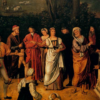5 Ways Spurgeon’s Metropolitan Tabernacle Cultivated Meaningful Membership
In 1854, when Charles Spurgeon began pastoring the New Park Street Chapel, he had a handful of deacons and a membership of 313 (though the actual attendance was much smaller). In just twelve weeks, they outgrew their space and made plans to enlarge their building. But almost immediately, they needed even more space, and so the church made plans to build a new building that would eventually become the Metropolitan Tabernacle.
Space issues were a problem, but more than that, Spurgeon suddenly found himself caring for a congregation that had grown far beyond his capacity.
This mattered to Spurgeon because of his ecclesiological commitments. He was not an itinerant preacher, and his church was not merely a preaching station. For all of his evangelistic preaching, Spurgeon refused to separate the call to the gospel with the call to be accountable to a local church. Spurgeon once stated, “I would rather give up my pastorate than admit any man to the Church who was not obedient to his Lord’s command; and such a course would certainly promote the downfall of any Church that practiced it.”[1]
For Spurgeon, this was not an idle commitment. In Spurgeon’s first six-and-a-half years at New Park Street Chapel, the church added 1,442 new members. That’s 1,442 membership interviews, 1,442 meetings with Spurgeon, 1,442 membership visitations, 1,442 testimonies before the congregation, and 1,442 approvals by the congregation—not to mention over a thousand baptisms, as most of these were new converts.
These numbers would only increase. For any pastor, Spurgeon not excluded, caring for a growing church can become a crushing load. And yet, Spurgeon refused to compromise his convictions for conveniences. Throughout his ministry, he pursued meaningful, regenerate church membership—and in doing so, the Metropolitan Tabernacle became an engine for gospel-ministry all around the world.
Here are five ways Spurgeon did this.
1) A Careful Membership Process
In the February 1869 edition of the Spurgeon’s magazine, The Sword and the Trowel (S&T), Spurgeon provides a six-step description of their membership process:
- An enquirer meets with one of the elders on a Wednesday evening and shares with them their testimony. Assuming a clear testimony has been shared, the elder records each testimony and schedules a meeting with the pastor for an interview.
- If the pastor is satisfied, at a congregational meeting, he will nominate an elder or church member as a “visitor.” This visitor will “enquire as to the moral character and repute of the candidate” by meeting with the candidate and talking to their neighbors, co-workers, family members, former church, etc. The goal is to find out whether there’s evidence of a life consistent with their profession of faith.
- If the visitor is satisfied, he will invite the candidate to attend a congregational meeting in which he or she will come before the church and answer any questions. According to Spurgeon, this happens “to elicit expressions of his trust in the Lord Jesus, and the hope of salvation through his blood, and any such facts of his spiritual history as may convince the church of the genuineness of the case.”
- After the statement before the church, the candidate withdraws, and the visitor gives his report.
- The church then takes a vote to receive him into membership.
- The person is publicly given the right-hand of fellowship after being baptized and participating in the next communion service of the church.[2]
With so many applying for membership, Spurgeon refined and made this process more efficient over the years, but never in a way that compromised the careful consideration of every potential member.
2) Working for Meaningful Membership
Spurgeon didn’t want to simply have people on the church rolls. He wanted to make sure Metropolitan’s church members continued in their profession of faith. In his last sermon to the Pastors’ College, Spurgeon urged his students,
Let us not keep names on our books when they are only names. Certain of the good old people like to keep them there, and cannot bear to have them removed; but when you do not know where individuals are, nor what they are, how can you count them? They are gone to America, or Australia, or to heaven, but as far as your roll is concerned they are with you still. Is this a right thing? It may not be possible to be absolutely accurate, but let us aim at it. . . . Keep your church real and effective, or make no report. A merely nominal church is a lie. Let it be what it professes to be.[3]
In a church of thousands, one of the ways Spurgeon pursued this was by tracking those who regularly came to the Lord’s Table. Upon joining the church, members were given a communion card, divided by perforation into twelve numbered parts, one of which was to be delivered every month at the communion. These tickets would be checked by the elders, and if any member was “absent more than three months without any known cause, the elder in whose district he resides is requested to visit him, and send in a report.”[4]
Often, in these visits, the elders would uncover pastoral needs. They’d find members who had drifted away from the faith, joined another church, or simply moved away. In every case, this prudential choice enabled the church to work toward meaningful membership either by providing better care and discipleship, or by removing some members from the membership.
3) Congregational Meetings as Discipleship
Congregational meetings became an essential part of Metropolitan Tabernacle, even though they primarily dealt with membership matters.
These meetings could last a long time. On May 18, 1860, 42 candidates appeared before the church, each giving his or her testimony. This meeting began at 2PM, and according to Spurgeon’s notes in the margin, “This most blessed meeting lasted till a late hour at night. Bless the Lord.”[5]
Unsurprisingly, these long meetings couldn’t be sustained, so the congregation began to host shorter meetings whenever they had the opportunity. Between the March and April communion services of 1874, the church held 12 congregational meetings and welcomed 93 members.
As is evident from Spurgeon’s note above, these congregational meetings were meant to be edifying. They were a necessary complement to the Word ministry of the church. According to both Spurgeon’s autobiography and Wonders of Grace, a book of testimonies from his early years, the congregation heard dozens of testimonies of people converted under Spurgeon’s preaching. But they also heard from new believers who heard the gospel through other ministries, or because another member invited them to church, or shared the gospel with them, or faithfully prayed for them for decades, and so on. In these meetings, the whole congregation saw both God’s power in salvation and their role in bringing the gospel to the lost.
4) Calling Elders
When Spurgeon first began his pastorate, the church only recognized the offices of pastor and deacons. However, as the church grew, the work of caring for the spiritual and temporal needs of the congregation became too much for the deacons to handle. And so, in January 1859, Spurgeon made a biblical case for the office of elder as one dedicated to the spiritual care of the church. The following motion was passed:
Whereupon it was resolved that the Church having heard the statement made by its pastor respecting the office of the eldership desires to elect a certain number to serve the church in the office for one year. It being understood that these brethren are to attend to the spiritual affairs of the Church and not to the temporal matters which appertain to the deacons only.[6]
From that time on, the congregation would annually appoint elders to labor alongside Spurgeon in the spiritual care of the congregation. The February 1869 edition of the S&T describes the elders’ job description:
The seeing of enquirers, the visiting of candidates for church membership, the seeking out of absentees, the caring for the sick and troubled, the conducting of prayer-meetings, catechumen and Bible-classes for the young men—these and other needed offices our brethren the Elders discharge for the church. One Elder is maintained by the church for the especial purpose of visiting our sick poor, and looking after the church-roll, that this may be done regularly and efficiently.[7]
Spurgeon lamented that most of Baptist churches didn’t have elders, and so he encouraged them to follow the New Testament pattern.
5) Cultivating a Working Church
An accurate membership roll is never a goal in and of itself. Rather, Spurgeon understood that a congregation full of people who genuinely loved Jesus and believed the gospel created an army that could shake the world. He constantly called his people to do something for God’s kingdom:
What odd notions people have of joining the church. Many a young man joins a rifle corps. There he is! When he joins the church, where is he? We have the distinguished honor of having the names of many young gentlemen on our books. But where are they? What are they doing? They think it enough that they have joined the church; and they don’t think that anything more is required. When they join a literary institute, or anything of that kind, they do so for the purpose of doing something, and obtaining an advantage from it; and I say to such young men, “Do you believe the Christian church to be a farce? If you do so, we could even dispense with your names; if you do not believe the Christian church is a farce, then show that you don’t by working so far as you can in the cause of Christ.” But we hear some say, “I could do nothing, though I were to try it.” Well, I would reply, “I would not have liked to say that of you. There is not a nettle in the corner of the churchyard without its virtues; there is not a spider in the world but has its web to spin; and there is no man in the world but has something to do for the cause of Christ, which nobody else can do but himself. I don’t think it is possible for you to be powerless. Can’t you speak to someone? Can’t you do something in your own place as a member of the church?”[8]
Oh, to get a working church! The German churches, when our dear friend Mr. Oncken was alive, always carried out the rule of asking every member, “What are you going to do for Christ?” and they put the answer down in a book. The one thing that was required of every member was that he should continue doing something for the Savior. If he ceased to do anything, it was a matter for church discipline, for he was an idle professor, and could not be allowed to remain in the church like a drone in a hive of working bees. He must do or go.[9]
The Metropolitan Tabernacle planted over a hundred churches. They sent out hundreds of pastors and trained hundreds of missionaries. Dozens upon dozens of charitable organizations began, and publications, tracts, and pamphlets were distributed throughout the world. The impact of this healthy church continues to be felt today.
To be sure, not every church will be the Metropolitan Tabernacle, and not every pastor will be Charles Spurgeon. But that’s never the goal. The goal is for every church and every pastor to be faithful—in doctrinal purity, in guarding the membership, in active gospel ministry. In this, both Spurgeon and the Metropolitan Tabernacle remain a model for pastors and churches today.
Editor’s note: This has been adapted from an article that originally appeared on The Spurgeon Center’s website.
* * * * *
FOOTNOTES:
[1] Charles H. Spurgeon, “Meeting of our Own Church,” Metropolitan Tabernacle Pulpit: Sermons Preached and Revised by C. H. Spurgeon (Pasadena, TX: Pilgrim Publications, 1970-2006), Vol. 7, 260.
[2] Charles H. Spurgeon, C.H. Spurgeon’s Works in His Magazine The Sword and the Trowel, Volumes 1-8 (Pasadena: Pilgrim Publications, 2004), 2:149-151.
[3] Charles H. Spurgeon, The Greatest Fight in the World: The Final Manifesto (Fearn: Christian Focus
Publications, 2014), 92-93.
[4] S&T, Vol. 2, 150.
[5] Church Meeting Minutes 1854-1861 New Park Street. Metropolitan Tabernacle Archives. Entry on May 18, 1860.
[6] Church Meeting Minutes 1854-1861 New Park Street. Metropolitan Tabernacle Archives. Entry on Jan. 12, 1859.
[7] S&T, Vol. 2, 149.
[8] Charles H. Spurgeon, Speeches at Home and Abroad (Pasadena: Pilgrim Publications, 1974), 60.
[9] Spurgeon, The Greatest Fight in the World, 96.








